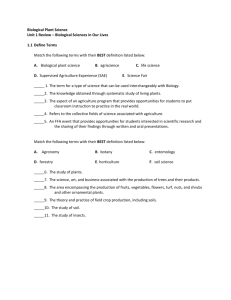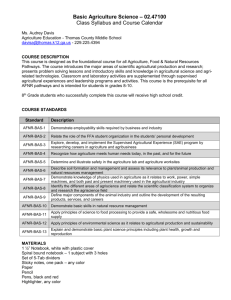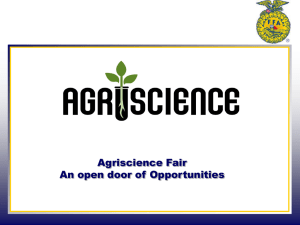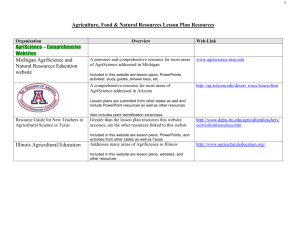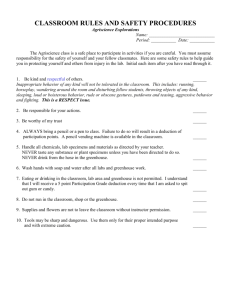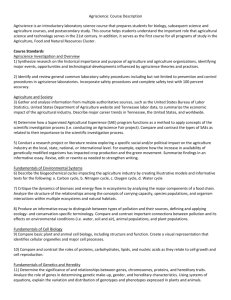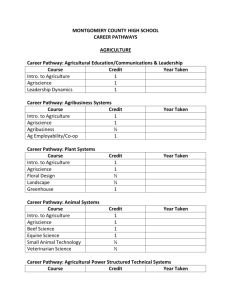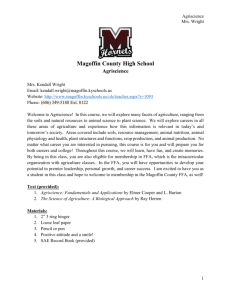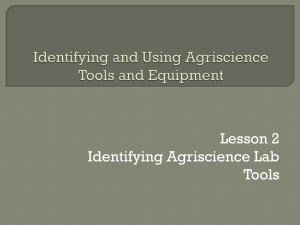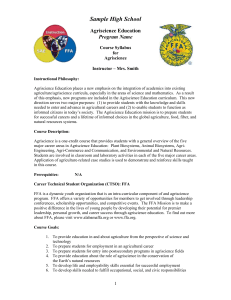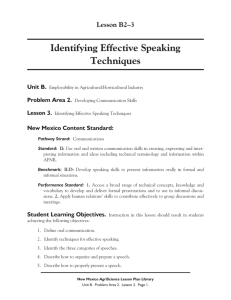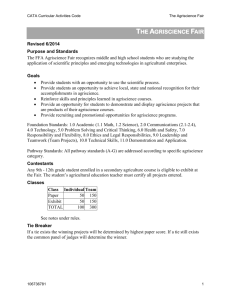Springport Agriscience Program Powerpoint
advertisement
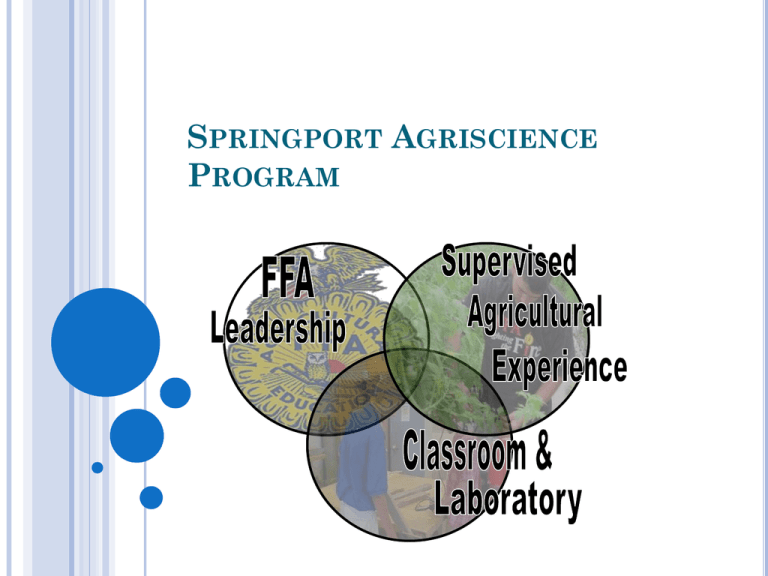
SPRINGPORT AGRISCIENCE PROGRAM HISTORY 1917 – Smith-Hughes Act created Vocational Agriculture 1928 – Future Farmers of America began November 4, 1940 – Springport Vocational Agriculture Program Began 1969 – Girls were allowed in FFA 1990 – Agriscience became a term in Michigan 1991 - Science Credit was granted for Agriscience Programs in Michigan 1998 – Springport began to offer science credit for agriscience courses IS THIS SCIENCE OR VOCATIONAL? BOTH: There are 2 sets of standards from the State of Michigan that programs have to meet HSCE for Biology CTE Standards 01.000 Agriculture, Agriculture Operations and Related Sciences CAREER AND TECHNICAL EDUCATION Teacher Vocational Certification Meet CTE Segments and Standards (which includes having a student organization – FFA) Create Program Completers Have an Advisory Committee Meet Facility Requirements Have Work-based Learning (SAEs) TRAC Audits (Technical Review Assistance and Compliance) State-Approved Programs are then eligible to receive Federal Carl D. Perkins (Perkins Act) dollars and matching State funds 01.000 AGRICULTURE, AGRICULTURE OPERATIONS AND RELATED SCIENCES 1. Safety 2. Animal Anatomy & Physiology 3. Animal Genetics and Reproduction 4. Domestic Animal Production 5. Animal Health & Nutrition 6. Plant Anatomy Physiology 7. Soils & Plant Nutrition 8. Plant Culture and Propagation 9. Natural Resource Systems 10. Environmental Service Systems 11. Agricultural Business & Marketing 12. Career Readiness & Leadership SPRINGPORT AGRISCIENCE SEGMENTS Biology-Botany - Segments: 1 - 6 - 7 - 8 - 9 - 11 (Biology credit & elective Science credit for graduation when combined with Biology-Zoology) Biology-Zoology - Segment: 1 - 2 - 3 - 4 - 5 10 - 12 (Biology credit & elective Science credit for graduation when combined with BiologyBotany) ADDITIONAL AGRISCIENCE COURSES Mechanical and Technical Systems - Segments: Q (Art credit for graduation) Genetics & Ag Research - Segment: Q (Elective Science credit for graduation) Ag Finance & Leadership - Segment: Q (Math credit when taken as 4th year math requirement for graduation) Ag Internship - Segment: Q (can be completed only after a student has finished all other segments) A COMPLETE AGRISCIENCE PROGRAM INVOLVES: Classroom and Laboratory Supervised Agricultural Experience (SAE) Projects Students gain knowledge and skill Students apply knowledge and skills to gain experience Leadership through FFA Students apply knowledge and skills to gain leadership skills COMPLETERS / CONCENTRATORS Concentrators are identified after they complete at least 7 segments with a grade of 2.0 or better. These students must complete the assessment at the time they exit the program. Completer's are students that completes all 12 segments with a grade of 2.0 or better and take the technical skill assessment, if available. Students will receive an endorsement on their diploma. Bio-Botany Bio-Zoology FUNDING 200 $150 Amount district receives per student (Sample Added Cost Factor) 0.92 Students in agriscience classes (this includes internship students) Per student per hour of contact time per day (we contact each student 55 minutes per day) $27,600 Amount generated by the agriscience program in state-aide and paid to the district if compliant with all CTE Standards PROGRAM FACILITIES Classrooms Merrill Henne Ag Room Mech/Tech Shop Ag Shop (animal room) Greenhouse Gardens Pasture/Land lab Barn FFA Intracurricular part of the agriscience program Students enrolled in an Agriscience Course are automatically in the FFA Participate in Student, Chapter, & Community Development SUPERVISED AGRICULTURAL EXPERIENCE (SAE) All FFA students are required to have a SAE On-site Opportunities: Farm Cooperative Agricultural Education Barn, Shop & Greenhouse Managers Communications PAST GRANT PROJECTS Growing Together: USDA Food Stamp Nutrition Education $154,000 Elementary Nutrition Teacher Nutrition Project Coordinator Summer Day Camp Nutrition Mentor Program Greenhouse in-floor Heat and Corn Burner: $16,000 Aquaculture: $4,500 Pasture Project and Pastured Poultry: $10,000 Livestock Gates: $5,000 Technology: $2,000 Community Service: $1,000 Gardening: $12,000 Alternative Energy: $5,000
